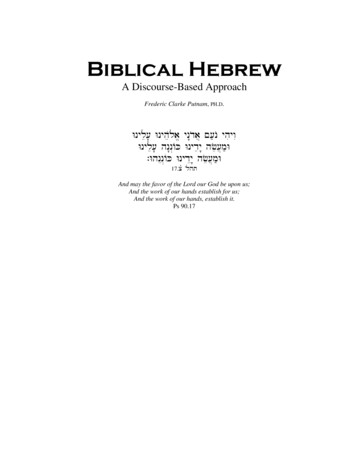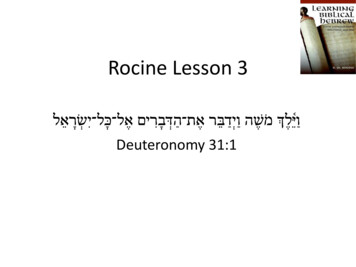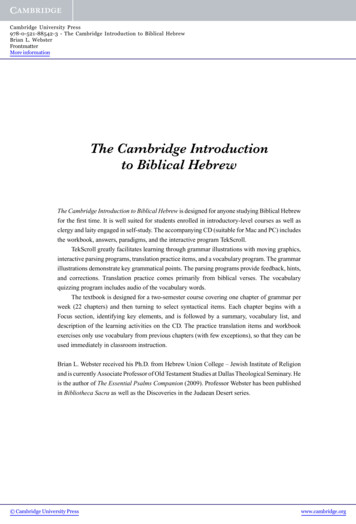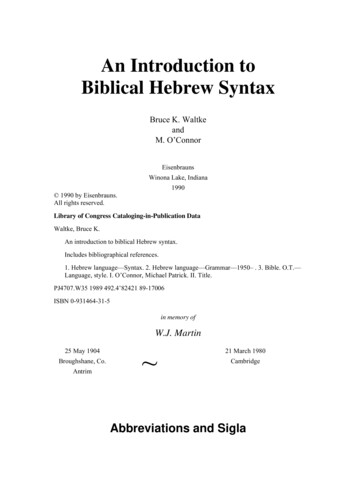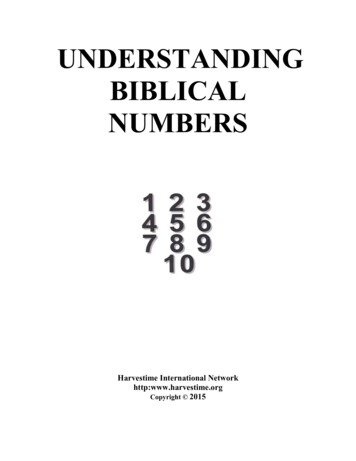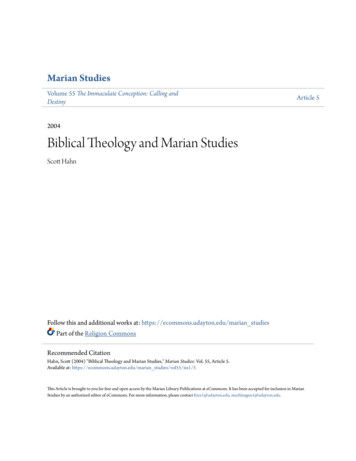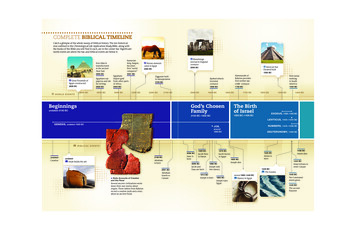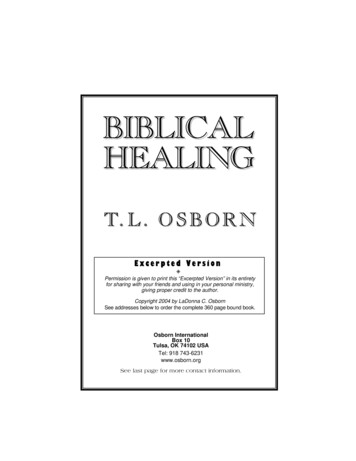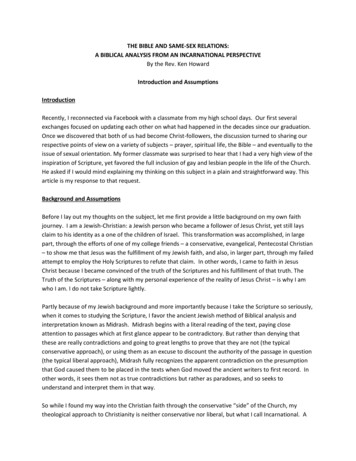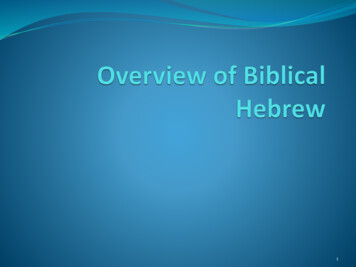
Transcription
1
Overview of Biblical Hebrew Before I begin this presentation of Biblical Hebrew, Iwant you to know that I recognize that not everyonehas the time to study Biblical Hebrew; but, I know many of you realize the importance ofbeing able to look at the Hebrew text that is behindthe English translations of the Bible.2
Overview of Biblical Hebrew If you fall into this category, you will get a lot out ofthis presentation that will help you to do just that. In addition, you will learn about certain resources thatcan help you study more effectively, and you will learnsome things you need to be aware of as you use theseresources. As we cover this information, I will do my best to pointout a few things that will help you to avoid certainerrors when looking at the Hebrew text.3
Overview of Biblical Hebrew For those who want to gain some level of proficiency inHebrew, this presentation will set you well on your wayto see the big picture of the language and prepare youfor the details of what you need to learn along the way. I guarantee you, this is one of the most helpful thingsyou can do before attempting to learn a foreignlanguage.4
Overview of Biblical Hebrew Before you start to look at verses and words in Hebrew,you need to learn the alphabet and understand thatHebrew is written right to left. If you don’t already know the Hebrew alphabet, youcan learn it as soon as possible. This requires repetition on your part.5
Aleph-BetLetterFinal Form Name/#Pronunciation א ּ , ב ב ג ד ה ו Aleph; 1(silent)Bet, Vet; 2ּ ב b as in boy; ב v as in vote ז Gimmel; 3 G as in gimmickDalet; 4D as in dollHe; 5H as in heyVav; 6V as in vote(Note Vav can also be spelled Waw)Zayin; 7Z as in zoo6
Aleph-BetLetterFinal Form Name/# ח ט י ּ כ ּ , ךּ כ ל מ ם נ ן PronunciationHet; 8Ch as in BachTet; 9T as in toyYod; 10Y as in yellowKaf, Kha; 20ּ כ ּ K as in keep; כ / ּ ך Ch as in BachLamed; 30L as in lookMem; 40M as in meNun; 50N as in name7
Aleph-BetLetterFinal Form ס ע ּּ , ף פ פ צ ץ ק ר Name/#PronunciationSamech; 60S as in sinAyin; 70(silent)Peh, Feh; 80P as in pay; F as in fameTsade; 90Ts as in catsQof; 100K as in keyResh; 200R as in rate8
Aleph-BetLetter ש ּ ש ּ ת Final FormName/#PronunciationShin; 300Sh as in shoeSin; 300S as in sinTav; 400T as in toyHebrew uses dots, dashes, and other symbols for vowels and accents. These areoutside the scope of this presentation.9
Overview of Biblical Hebrew As you begin to explore Biblical Hebrew, I suggest anyof the following resources: Bible software with Hebrewresources that are on-line oroff-line. Depending on what you use,you may need to download theHebrew fonts onto yourcomputer that are used on aparticular web site.10
Overview of Biblical Hebrew Computer software includes programs such as: Blue Letter Bible – free, on-line CD available for donation eSword – free, for off-line use PC Study Bible Bible Works Logos Accordance11
Overview of Biblical Hebrew Several printed concordances and lexicons to consider: Strong’s ConcordanceEnglishman’s Hebrew Concordance of the Old TestamentWord Study ConcordanceBrown-Driver-Briggs Hebrew Lexicon (BDB)Theological Wordbook of the Old Testament (TWOT)Analytical Hebrew-Chaldee LexiconNew International Dictionary of Old Testament Theology andExegesis12
Overview of Biblical Hebrew Use an Interlinear Bible (English equivalent is directlyunder the Hebrew text) until you can do without it. Avoid parallels (text is side by side) Avoid small font size – look at the text before youbuy!!! DO NOT GET: The Interlinear Hebrew-Greek-English Bible,One-Volume Edition by Jay P. Green. The Hebrew isimpossibly tiny.CONSIDER: Hebrew-English Interlinear Old Testament BibliaHebraica Stuttgartensia (BHS)/English Standard Version (ESV)or something else.13
Overview of Biblical Hebrew A Strong’s Concordance shows how a particular Greekor Hebrew word is translated in the English version ofthe Bible. It is not a lexicon. An Englishman’s Concordance lists all the verses wherea particular Greek or Hebrew word is used. A lexicon is a dictionary for Greek and Hebrew words.14
Overview of Biblcal HebrewBlue Letter Biblehas various Bibleversions, andclickable links toaccess referencetools.15
Overview of Biblical HebrewBlue Letter Bibleis found athttps://www.blueletterbible.org/16
Overview of Biblical Hebrew17
Overview of Biblical HebrewEnglishman’s Concordance, PC Study Bible18
Overview of Biblical Hebrew Hebrew Grammars: I suggest using a grammar with an inductive approach to learning Hebrew for beginners, asopposed to a seminary level grammar. Get at least two grammars (one that is inductive or for self-study, and another that isrecommended for seminary use). Learn Biblical Hebrew by John H. Dobson (with CD) inductive The First Hebrew Primer: The Adult Beginner's Path to Biblical Hebrew, Third Edition 2005 byEthelyn Simonand Linda Motzkin. Order book and audio CD fromhttp://www.ekspublishing.com/biblical-hebrew Introducing Biblical Hebrew by Allen Ross (Charles Grebe teaches this text l for FREE – donations accepted). Biblical Hebrew A Compact Guide Copyright 2012 by Miles V. Van Pelt. Zondervan.19
Overview of Biblical Hebrew Once you start to look at verses and words in Hebrew, you’llsee that some words appear in a Hebrew lexicon orconcordance the same way they do in the verse beingstudied. These can be words like: Proper nouns Prepositions Masculine singular nouns and adjectives Certain 3rd person, masculine, singular verbs Interrogative pronouns20
Overview of Biblical HebrewExample ofpropernoun fromeSword 21
Overview of Biblical Hebrew Additionally, you may be surprised to notice that somewords in Scripture aren’t spelled exactly the same asthey are in a concordance or lexicon. There are a variety of reasons for this.22
Overview of Biblical Hebrew Hebrew words often have prefixes and/or suffixesattached to them. These need to be removed in order to recognize thelexical form of the Hebrew word.23
Overview of Biblical HebrewIII-II-II-Nun verb: Conjunctive vav (prefix) followed by 3rd person masculineplural suffix for hiphil perfect verb. Note the addition of a ה , a dot(dagesh), and the change in vowel ( )ִי in the hiphil form of the perfect verb.Example from PC Study Bible V524
Overview of Biblical Hebrew Hebrew prefixes can be: An interrogative (?) particle [usually ֲ ;]ה The definite article (the) [usually ּ ִּ ַ ;]ה The conjunctive vav (and, but, then) [usually ]ו ּ Inseparable prepositions [such as ּ ב , ל , ּ ;]ְְכ Verb prefixes (imperfect verbs) Care should be used to make sure you do not removeone of these letters when it is really part of the originalword itself.25
Overview of Biblical HebrewGenesis 1:1 א ררץ ץ ָּ ָּ מים ּואא ֵ֥ת ה ַּ ש ָּ ּ ַ בּרא אשית בָּּרָּ ָ֣א אֱל ֹה ִ֑ים אא ֵ֥ת ה בּרא אשית in the beginning בָּּרָּ ָ֣א he created (3rd person, masc. sing. perfectverb) ּ מים ַ ָּ ש ּ ַ ה the heavens ּואאת and definite direct object marker ( )אאת א ררץ ץ ָּ ָּ ה the earth26
Overview of Biblical Hebrew In English we don’t have a direct object marker ( )אץת that points out a definite direct object. Example of a direct object with a definite article (the): Lee played the keyboard. Subject verb Definite Article Direct Object If we were to write this with a definite direct objectmarker, it might look like this: Lee played ) ( אץת the keyboard.27
Overview of Biblical Hebrew Hebrew suffixes can be: Feminine endings for adjectives and nouns Plural endings for adjectives and nouns Pronominal suffixes (possessive or objective for genderand number) The Directional particle Verb suffixes for gender and number28
Overview of Biblical HebrewFemininepluralsuffix29
Overview of Biblical HebrewPronominal SuffixThe yod indicates this is amasculine plural noun.30
Overview of Biblical HebrewPronominal Suffixes on Adon ( )אָּדוֹּן Transliteration# HitsMeaningPerson & Number אֲדֹנ ָּי Adonai420LORD;YHVHPlural in form אֲדֹנ ַי Adonai1My lords1 common plural(see Genesis 19:2) אֲדֹ ּני Adoniy167My lord1 commonsingular31
Overview of Biblical Hebrew Incidentally, אֲד ֹּני means “sir” in modern Hebrew.32
Overview of Biblical Hebrew Other changes in words may also be seen: In vowels of verbs, nouns, and adjectives; At the end of constructs (a form of a word) which showpossession. אֲדֹנ אי is a construct form of Adon ( ;)אָּדוֹּן it means “lordof”33
Overview of Biblical HebrewAnotherexample of aconstructchain: let themhavedominionover the fishof ( בדג ַת construct)the sea ( הַיּ ָּּם absolute) (Gen 1:26NKJ)Example fromBibleWorks 934
Overview of Biblical Hebrew2 Samuel 2:1Here’s an example of one interrogative Heh (prefix) and twodirectional particles (suffix )ִ ָּה .This is from The Hebrew-English Interlinear ESV OldTestament by Crossway.35
Overview of Biblical Hebrew Part II36
Overview of Biblical Hebrew When you are using a Hebrew lexicon, it is importantto have an over-all view of the Hebrew verbal system. Verbs are probably the most important, timeconsuming, and difficult part of learning BiblicalHebrew.37
Overview of Biblical Hebrew Verbs are composed of a 3-consonantal root called ashoresh. Each letter of the root is numbered (right to left): III – II – I These become important when identifying weak verbs;these usually involve guttural letters ( א , ה , ח , ע , )ר inone of these 3 positions.38
Overview of Biblical Hebrew Depending on the form of the verb, prefixes and/orsuffixes are added to identify the person(s) doing theaction of the verb. Sometimes a second suffix, called a pronominal suffixis also added to indicate a direct object that is apersonal pronoun.I saw him.Subject (1st, 2nd, or 3rd person) Verb--Direct Object Personal Pronoun39
Overview of Biblical HebrewIII-II-IRoot (III- )ה - 1st person, common singular, perfect ( )ִי - 2nd personmasculine singular pronominal suffix. ָּ ך ּ תי ּ צ ּו ּי 40
Overview of Biblical Hebrew The shoresh is the root or stem of a verb. Another word we need to know is binyan; it comesfrom the root/verb ( בָּּנ ָּה banah) which means build. Binyanim (plural) result from certain changes to theverb’s stem. Each binyan has a name based on how theverb is built.41
Overview of Biblical Hebrew Different verbal stems [binyan (sg) or binyanim (pl)]are formed with a 3-consonantal root (shoresh) by: Changing the vowel points; Sometimes by adding a dot called a dagesh; Sometimes by adding a prefix. Be aware that some verbs have: Bi-consonantal roots (only two root letters) Missing root letters (either I or III)42
Overview of Biblical HebrewQal3rd Person, Masc.Sing. Perfect קָּטַל 3rd Person, Masc.Sing. Imperfect ּיקטֹל NiphalPielPual ּנקטַל קטּאל קֻטַּל קּטאל ָּ ּי ּיקַטּאל ּיקֻטַּל HitpaelHiphil התקַטּאל הקטיל יתקַטּאל ּי ַקטיל Hophal הָּקטַל ּי ָּקטַל BinyanHere I just want you to note that there are different prefixes, dageshes,and vowel changes in the various binyanim for the verb qatal (to kill).43
Overview of Biblical Hebrew It is outside the scope of this presentation to teach youeverything regarding the construction of every verbform. For now we will try to stay as general as possible whilegiving you basic information you need to knowwhether or not you choose to pursue studying BiblicalHebrew.44
Overview of Biblical Hebrew Before I give a general overview of the binyanim, we needto understand what active, passive, and reflexive is. Active when the subject is doing the action. The boy (subject) hit the ball. Passive when the subject is receiving the action. The boy (subject) was hit by the ball. Reflexive when the subject does something tohimself. The boy (subject) hit himself with the ball.45
Overview of Biblical Hebrew The 7 major (most common) binyanim are: Qal active voice, simple basic action Niphal passive voice, simple basic action Piel active voice, intensive action, causes state to exist Pual passive voice, intensive action Hitpael reflexive voice, intensive action Hiphil active voice, causal action Hophal passive voice, causal action The vast majority of the verbs in Scripture are Qal. (Note: Slight spelling differences in the binyanim may be seen in variousgrammars.)46
Overview of Biblical Hebrew You may see a few more binyanim mentioned in yourlexicon or grammar that are considered to be minor: These are used with bi-consonantal and geminate(twin) roots. Polel – same meaning as Piel (active voice, intensiveaction) Polal – same meaning as Pual (passive voice, intensiveaction) Hitpolel – same meaning as Hitpael (reflexive voice,intensive action).47
Overview of Biblical Hebrew This description of the binyanim is very basic. There are more specific uses of the binyamin thataffect a verb’s meaning. You’ll have to learn these froma Hebrew grammar. It’s also important to consult your lexicon for themeanings of the various binyanim.48
Overview of Biblical Hebrew Verbal stems (binyanim) affect a root’s meaning; notits function within a discourse (a section of writing). If your lexicon gives you meanings for a verb’s variousbinyanim, you must consider only the definitions forthe specific binyan in the verse you are looking at.49
Overview of Biblical Hebrew Your computer software should tell you what binyan isused in the verse you are looking at. If you aren’t using computer software, you can alsoconsult the Analytical Hebrew and Chaldee Lexicon. BTW, Hebrew verbs do not always exist in everypossible binyan.50
Overview of Biblical Hebrew Let me ask you a question 51
Overview of Biblical Hebrew Did you ever ask your mom how to spell a word andhave her te
Overview of Biblical Hebrew As you begin to explore Biblical Hebrew, I suggest any of the following resources: 10 Bible software with Hebrew resources that are on-line or off-line. Depending on what you use, you may need to download the Hebrew fonts onto your computer that are used on a


